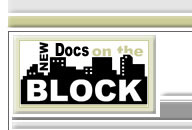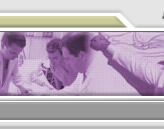
by Jarrod Shapiro, DPM
We
spend much of our time in residency performing surgery and perhaps
an equal amount of time thinking about how to do surgery. What's the
best procedure for a bunion with a hypermobile first ray and large
IM angle? What's the most effective fixation method for a triple
arthrodesis? Is external fixation best for calcaneal fractures? Much
of our literature revolves around surgery. It's not McGlamry's
Textbook of Foot and Ankle Conservative Care is it? As a new
practitioner, though, I'm coming to realize the vast majority of
medical practice is conservative in nature, which we're often not
educated well to perform.
As a resident, conservative care is often
something mentioned in passing, such as "when such-and-such
conservative therapy fails, surgery is the next step." We don't
spend as much time on conservative care as we do on the surgical
side. Obviously, any surgical procedure compared head to head with
any conservative modality is more complicated with more potentially
harmful effects and requires more thought and training. However, I
advocate to you that conservative care is what you'll perform the
vast majority of the time in the office, there's little science
behind it, and almost every elective surgery you will perform will
have some form of conservative care preceding it. As much as you
might wish it, not every patient is going to walk into your office
demanding surgery. Image that!
Just as in surgery, I've spent a good bit of
time watching my trainers in their offices, absorbing their styles.
I've carefully observed my attendings deal with patient care,
specific conservative therapies, and complications. The best
practitioners seem to have a system established for conservative
care. Here's an example. When a patient comes in complaining of heel
pain diagnosed as plantar fasciitis, one of my attendings would
provide a 10 point treatment plan consisting of: education,
nonimpact exercise, running shoes, OTC insoles, calf stretches,
icing, and sometimes injections. If they're not improved at least
50%, he prescribes a night splint, NSAIDs, custom orthotics, and
physical therapy at subsequent visits.
Regardless of your opinion about this
treatment regimen, the effective part is that the treatment plan was
comprehensive and treated the etiology of the problem. He also
communicated clearly and without hesitation. You have to be
convincing when you're telling a patient how you're going to treat
them. A lack of clarity or confidence on your part may be confused
with incompetence. This is the art of conservative care.
I'd love to see a textbook on conservative
foot and ankle care. How long should a cam walker be left on for an
Achilles paratendonitis? What therapies are available for PTTD other
than Arizona and Ritchie braces, etc? What about those diffuse, hard
to diagnose conditions like "metatarsalgia." What are the best ways
to accommodate that hallux valgus in the nonsurgical candidate? What
role does padding and taping have? What about shoes? Would it not be
a fabulous resource to us new physicians to have a conservative
McGlamry? I'd appreciate an up-to-date text that discusses this
facet of podiatric care from national experts. I'd buy that book!
Talk to me,

Jarrod Shapiro, DPM
PRESENT Resident Editor
[email protected]

Ask, and ye shall
receive....

PRINCIPLES AND PRACTICE OF PODIATRIC MEDICINE
* 2 volumes / 1,516 pages / 1,400 figures and tables
A Comprehensive Guide to All
Essential Principles of Podiatric Medical Practice
| "If I owned just one book in podiatry school and the years
thereafter, it would be this one. Levy and Hetherington have effectively
eliminated all the handouts, reprints and notes that we use in school. They have
highly refined and organized the podiatric body of knowledge, and published it
all together in one comprehensive text. This book has become THE required text
for podiatry students at all podiatry colleges, and should be on the bookshelf
of every living podiatrist. Two of our greatest teachers have produced a
masterpiece. Bravo !"
Alan Sherman, DPM
Founder, Podiatry Online and PRESENT e-Learning Systems |
About the Editors
Leonard A. Levy, DPM, MPH
Associate Dean for Education, Planning and Research; Professor of
Family Medicine/Professor of Public Health, Nova Southeastern University College
of Osteopathic Medicine, Fort Lauderdale, FL.
"The purpose of the book is to provide a comprehensive textbook for students, a
ready reference for practitioners, and an aid to preparing for board
examinations. The book addresses all areas of practice, including both
conservative and surgical care, and it provides a basic science review in the
areas of anatomy, biomechanics and biomaterials."
Vincent J. Hetherington,
DPM |
|
Vincent J. Hetherington, DPM, MS
Vice President and Dean of Academic Affairs; Professor,
Department of Surgery,
Ohio College of Podiatric Medicine,
"Enough detail is provided to make it an invaluable
resource no matter what level the reader is within the health professional
community"
Leonard Levy, DPM, MPH
|
Data Trace Publishing brings you this long awaited,
one-stop resource on current podiatric medical practice. Inside, you'll find the
most up-to-date information on podiatric issues from experts in the field. The
text's wide reaching scope encompasses major topics like foot and ankle
disorders and injuries, surgical procedures, and rehabilitation, but also offers
insights into behavioral medicine, alternative therapies, and the role podiatry
plays in the fight against epidemics and disease.
The combination of theory and practice make it a
must-have reference for students, residents, and practicing physicians.
To learn more or order PRINCIPLES AND PRACTICE OF
PODIATRIC MEDICINE, 2nd ed., call Data Trace at 800-342-0454 or order online at:
https://datatrace.com/medical/principle_present_body.htm
|
TABLE of CONTENTS |
|
1. The Evolution of Podiatric Medical Practice and Formal
Education: Chronological History
-Leonard A Levy
2. Sectional Anatomy of the Foot
-Scott
Leum, Wayne A Krueger
3. Normal Biomechanics
-Robert
D Phillips
4. Pathomechanics of Common Foot Pathologies
-Scott
A Spencer
5. The Podiatric History and Examination
-Myron
C Boxer
6. Lower Extremity Edema
-Lawrence
Harkless, Khurram H Khan
7. Pruritus in the Podiatric Medical Patient
-Leonard
A Levy
8. Pain Management
-Kyle
E Hoogendoorn, Brian F Griffin, Cheryll, L Robinson
9. Podiatric Radiology
-Ronald
E Johnson
10. General Radiology of the Foot and Ankle with Special
Focus on Pedal MR Imaging
-Lawrence
Osher
11. Skin Biopsy in Podiatric Medical Practice
-Leonard
A Levy
12. Evaluation of Arterial Flow in the Lower
Extremity
-Arlene
F Hoffman
13. Laboratory Medicine: Evaluation and Diagnosis
-Harry
Burke
14. Infectious Diseases
-Bryan
D Caldwell, Donald J Adamov
16. Tumors of the Skin of the Lower Extremity
-Bradley
W Bakotic
15. Tumors of the Small Bones of the Distal LowerExtremity
-Bradley
W Bakotic
17. Tumors of the Soft Tissue of the Lower Extremity
-Bradley
W Bakotic
18. Hematopietic Tumors of the Lower Extremity
-Bradley W Bakotic
19. Arthritis
-Myron
C Boxer, Leonard A Levy
20. Peripheral Nerve Disorders
-Mark
E Landry
21. Vascular Disorders
-Anthony
S Kidwa
22. Dermatologic and Soft Tissue Disorders
-Daniel
J McCarthy, Bryan D Caldwell
23. The Nail Unit: Diseases and Disorders
-Myron
A Bodman
24. Operative Care of Nail Disorders
-John
E Laco
25. Diabetic and Insensitive Foot
-Vincent J Hetherington, Victoria Penfield,Richard Stess
26. Amputation of the Foot
-Edward
L Chairman
27. Foot Disorders Associated with Aging
-Arthur
E Helfland |
28. The Pediatric Patient
-Vincent
J Hetherington, Janis Lehtinen, Franz Grill, Lawrence Lembach
29. Podiatric Sports Medicine
-James
E Lichniak, Phillip R Perlman
30. The Handicapped and Disabled Podiatric Patient
-Leonard
A Levy
31. Behavioral Medicine
-Leonard
A Levy
32.
The Plague of HIV/AIDS: Role of Podiatric
Medicine
-Leonard
A Levy
33. Basic Operative Procedures: Techniques and
Instrumentation for Debridement of Nail and Hyperkeratotic Tissue
-Robert
A van Lith
34. Orthodigita Techniques
-Kendrick
A Whitney, Alan K Whitney
35. Padding and Taping Therapy
-Alan
K Whitney, Kendrick A Whitney
36. Basic Concepts of Rehabilitation
-Michael Korbol
37. Management of Lower Extremity Ulcers
-Kenneth
G Canter, Gerit D Mulder, David J Neese
38. Introduction to Anesthesiology for Podiatric
Medicine
-Robert
C Rogoff, H Nkrumah Huntley
39. Local Anesthetics
-Gregory
S Duncan
40. Perioperative Considerations in Podiatric Surgery
-Brian
Novack
41. Lesser Metatarsal and Digital Surgery
-Vincent
J Mandracchia, Denise M Mandi, Brent D Haverstock, Donald E Buddecke, Jr, Eric A
Barp, W Ashton Nickles
42. Hallux Valgus, Hallux Limitus, and First Ray
Surgery
-Vincent J Hetherington, Stephen F Mielech
43. Basics of Rearfoot Surgery
-Gunther
Steinb?ck, Aaron Chokan
44. Collapsing Pes Valgo Planus
-Stephen
J Miller
45. Pes Cavus
-Harold W Vogler, Daniel J Howard
46. Complex and Compound Foot and Ankle Deformations:
Paralytic and Nonparalytic
-Harold
W Vogler, Gary R Bauer
47. Arthroscopy
-Matthew
DeMore, III, Joseph Favazzo
48. Soft Tissue Trauma of the Lower Extremity
-Vincent
J Mandracchia, Donald E Buddecke, Jr, Scott C Nelson, Trenton K Statler, Donald
W Hayes, Jr, Denise M Mandi
49. Foot Fractures
-George
S Gumann, Jr
50. Ankle Fractures
-Harold
W Vogler, Gary R Bauer
51. Postoperative Complications in Podiatric Surgery
-Marc
Dolce, Donald J Adamov
52. Fixation Techniques in Foot and Ankle Surgery
-Lawrence
DiDomenico, Dave Garchar
53. Basic Biomaterials
-Jill S Kawalec, Vincent J Hetherington
54. Surgical Wound Closure in Foot and Ankle
Procedures
-Jose Castillo, Gary P Jolly
55. Clinical Indications of MRI Use in Podiatry
|-Brian
Novack, Marie Blazer |
To order learn more or order PRINCIPLES AND
PRACTICE OF PODIATRIC MEDICINE, 2nd ed., call Data Trace at 800-342-0454 or
order online at:
https://datatrace.com/medical/principle_present_body.htm

This program is supported by an
education grant from
Dermik Laboratories.


|

















